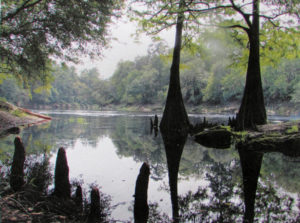Work In Progress: Suwanee River, Update 2
If we are just going to copy a photo or scene our task is simplified to a great degree. But many times the photo of the scene doesn’t do justice to what lies before us. Not only is there a vista that the eyes can take in but there is a feeling, an emotion that is elicited from the experience. The mind’s eye may amplify certain aspects of the scene that support a feeling elicited, or ignore other aspects that interfere with that feeling. Our mind’s eye idealizes the scene before us – romanticizes it. We can visualize other things in the scene or consciously alter aspects, such as time of day or year, or the placement of the sun that can heighten the feeling. As we gaze upon the landscape we make judgments about what is important and what is not in conveying the feeling and emotions. It should be our undertaking as artists to portray the scene before us not as it actually appears in its infinite detail, but as it affects us emotionally – to simplify it, to emphasize those parts that are important to the message.
That’s not an easy task – for me. I’ve been focused over the past seven years on painting scenes just as I see them. I started off by reproducing scenes as I saw them – with all their detail. Then I learned to improve the compositions by adding and removing, moving things around, creating focal points and centers of interest, but I still retained a great amount of detail. I thought attention to detail would improve my paintings. The more I read and the more I watched other great artists, the more I began to question that idea. Increasing detail in my paintings didn’t result in increasing satisfaction or a feeling of improvement. I began to realize that increasing detail wasn’t the answer. Rather, it was reducing detail, simplifying, and rather than portraying what I see, portraying what I feel.
I have come to equate time spent to complete a painting with quality. The more time spent (mostly on detailed drawing), the better the quality. Not true! The time that should be spent on the painting shouldn’t be on attention to detail but in what needs to be included to convey the idea and emotion I feel being enveloped by a scene and it’s affect on me. It is emotion that is important, not accuracy.
Now, for some thoughts on how to portray this landscape scene along the Suannee River.
- What does this scene mean to me? What am I feeling that I want to convey to viewers?
I’m standing in the shade, looking out into a warm, sunny morning on a peaceful, slow moving river. Overhead, the canopy of bald cypress and oaks, and a gentle breeze cools me. Beyond the shade, out in the open, the sun is still low in the sky, but it is warming the trees on the far bank of the river, resulting in a play of contrasting lights and darks.
- Should there be dramatic contrasts of lights and darks?
- Should the trees be backlighted or should the sun be coming from the side?
- The color of the sky, as well as the reflection in the water is light near the trees and darkens with height. The sky can be warmed with a very light peach in the lighter areas.
- A center of interest or focus? A lone bird or two in the distance? A kayaker?
- Time is late morning. The sun is still low in the sky and warming the tops of the trees on the far bank.
- Clouds?
- Keep the linear, horizontal line of white reflection from the sky. Maybe add a few minor streaks here and there below it. It makes a nice focus. It could also be used as an arrow leading the eye to a center of interest.
- Where do I concentrate detail? What is important to convey the message and what only complicates and blurs the message? Thought needs to go into what is important to tell the story. What is necessary to support the message and what is not necessary? How much detail is necessary to convey my idea and when does it become distracting. I don’t want an abstraction but I also don’t want too much detail.
- The converging diagonals of the tree line, the white reflection and the upward pointing cypress knees help to present the center of interest.
- Use an underpainting of warm colors to emphasize the warmth of the light and to make the greens more interesting.
- Do I add complementary colors to the underpainting?
- Use cool blues in the shadows. Where the shadows become lighter as they approach the sunlit areas should I add warmer blues (purples) to the mix?
- Add mid tone purples to the sky as an undertone?
Now, I’ll work up some color sketches based on these thoughts and see what I can come up with.
